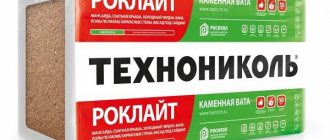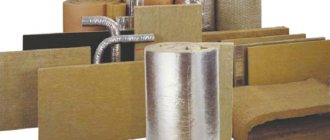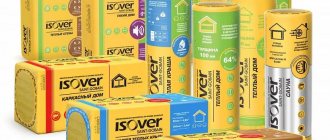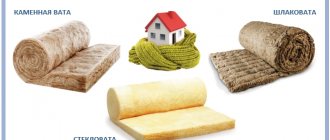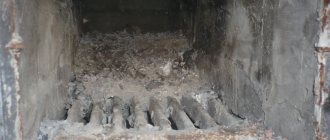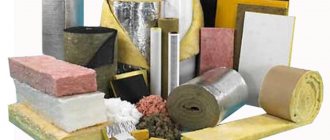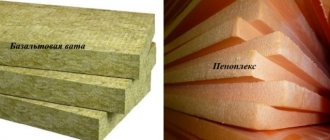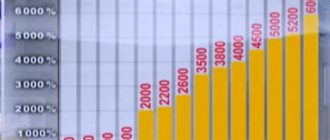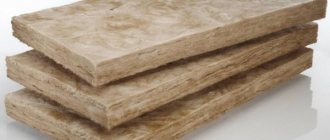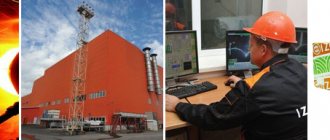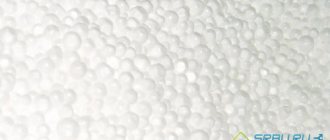Mineral wool for wall insulation and its sizes: 11 options
When choosing insulation, carefully study the characteristics of mineral wool so that it meets all the requirements. You can insulate the house yourself. This can be done easily and simply if you decide on the type of thermal insulation material and become familiar with the nuances for its installation. When choosing insulation, special attention should be paid to the properties of the material. Mineral wool dimensions are an important issue that needs to be resolved before laying the material. Mineral wool of different lengths, thicknesses and widths is suitable for a specific type of work.
Optimal thickness of mineral wool for roofing and other house structures
The required dimensions are selected during design. It is important to correctly determine the thickness of the thermal insulation material that will be used in walls, roofs and other building structures. The following depends on the thermal insulation layer and its density:
- durability of building elements;
- room temperature;
- level of living comfort of people.
The stone wool used, the dimensions of the slab of which are selected correctly, will effectively retain heat in the rooms of the house. It will not escape through the outer walls, roofing, floor of the first floor and other structures of the building. Proper insulation allows you to reduce energy consumption in the winter months, and use the air conditioning system less often in the summer.
On a note! Professionals believe that approximately 20% of the heat can escape from the room through the roof structure if only the attic floor of the house is insulated. In this case, there is no thermal insulation material in the roof itself.
The main heat losses through the external structures of a residential building Source santehnika-nk.ru
During the operation of the house, the owner may often decide to expand the living space. This problem is solved by constructing extensions or arranging premises that were not previously used for the permanent presence of people. One of such spaces in the house can be the roof. They make an attic out of it. In this case, there is no way to do without insulation. Thermal insulation materials will also be required if there is a need to improve the energy efficiency of the building.
During the construction or reconstruction of a house, mineral wool is almost always used. After all, it has better properties compared to polystyrene foam. Moreover, the latter material with a foam structure is not recommended for use when constructing a roofing pie. After all, it is a flammable and harmful insulation material. In addition, a mineral wool board is cheaper compared to the price of polystyrene foam.
When choosing insulation, the weight, hygroscopicity, and shape stability of the heat-insulating material are taken into account. After all, it should not create additional load on building structures, not absorb water and not deform.
Mineral wool slabs are almost ideal for home insulation Source saucyintruder.org
The material used must also have high fire resistance, durability and environmental friendliness. These requirements are fully met by mineral wool slabs made from basalt raw materials, which are produced by different manufacturers in large quantities.
The optimal thickness of mineral wool is selected by specialists as a result of thermal engineering calculations. During this process, two main parameters are taken into account. One of them is the thermal conductivity coefficient. It is known for each type of thermal insulation material. To designate it, the letters λB are used, and this characteristic is measured in W/m*K.
Manufacturers of insulation usually indicate the thermal conductivity coefficient on the packaging. It can also be found from the material certificate. Knowing this characteristic, the ability of the insulation to retain heat is assessed. The thermal conductivity coefficient should be as low as possible.
Important! In the case of mineral wool, this characteristic is a minimum of 0.038 W/m*K, and a maximum of 0.055 W/m*K.
Mineral wool has a maximum thermal conductivity coefficient of 0.055 W/m*K Source grandmetal26.ru
Standard insulation sizes
The leader in the market of thermal insulation materials is. It produces plates, mats, rolls and cylinders. Varieties of mineral wool are used to insulate a specific type of structure. To insulate the frame structure, mineral wool is usually used, in which the thickness is 46-213 mm, the width ranges from 566 to 612 mm, and the length is 1175 mm.
For thermal insulation of walls, roofs, facades and other parts of buildings, as well as for insulation of equipment, mineral wool with a thickness of 50 to 150 mm is used
For high-quality sound insulation of multilayer walls, mineral wool of the following sizes is used: thickness - from 51-101 to 205 mm, width - from 613 mm, length - from 1175 mm.
Flat roofs are usually insulated with wool, which has the following dimensions: thickness - from 55 to 175 mm. Width – from 1195 mm, length – from 1280 mm. All sizes of mineral wool can be found in special catalogs. The most common method of insulation outside and inside is laying mineral wool mats on frame structures.
Wool sizes:
- ISOVER M34 – 40 mm by 200 mm, 610 mm by 1220 mm. 3000 mm by 9000 mm;
- Frame-M37 – 42 mm by 203 mm, 610 mm by 1220 mm, 3000 mm by 22000 mm;
- ISOVER M40 – 50 mm by 200 mm, 610 mm by 1220 mm. 3000 mm by 9000 mm;
- Frame-M40 – 50 mm by 200 mm, 50 mm by 1200 mm, 7000 mm by 14000 mm.
To insulate the pipelines, it is necessary to use cylinders of mineral wool. Typically, for thermal insulation of roofs, facades, walls and other parts of a building, Knauf mineral wool is used, which is presented in the following variation: thickness - 55-155 mm, while its length and width can vary. The latter characteristics should be selected based on ease of use.
Example of insulation calculation
Table of wall thickness depending on the selected material and region of the country
The choice of thickness for a heat insulator must begin with the fact that the material is selected according to its intended purpose for a specific room and temperature zone. All zones that are used for calculations can be found in special reference books. Among the frequently used 4 are:
- 1 zone: from 3501 degree days;
- Zone 2: 3001-3501 degree days;
- Zone 3: 2501-3000 degree days;
- Zone 4: up to 2500 degree days.
The following calculation options can be cited as an example:
- The minimum permissible values for thermal resistance are represented by 4 zones of 2.8; 2.5; 2,2 and 2.
- Floors, coverings for unheated, unused attics: 4.95; 4.5; 3.9; 3.3.
- Cold basements, ground floors: 3.5; 3.3; 3; 2.5.
- Floors for unheated plinths and basements located at ground level: 2.8; 2.6; 2.2; 2.
- Floors for basements located below ground level: 3.7; 3.45; 3; 2.7.
- Balcony structures, display windows and panoramic windows, walls around them, translucent special facades, verandas, covered terraces: 0.6; 0.56; 0.55; 0.5.
- Front doors for apartment buildings, hallways for large public buildings: 0.44; 0.41; 0.39; 0.32.
- Entrance premises, corridors, hallways, halls for private low-rise buildings: 0.6; 0.56; 0.54; 0.45.
- Entrance halls and halls for premises located above the ground floor level: 0.25; 0.25; 0.25; 0.25.
Using this indicator, you can calculate the thickness of the heat insulator of any structure. For example, the walls of a house are built of 51 cm sand-lime brick. The insulation is made using 10 cm foam plastic boards. To determine whether the planned thickness of the insulation is suitable, you simply need to calculate the coefficient for the thermal resistance of the foam plastic and the wall, after which the obtained values are added and compared with those which are presented above.
For walls 51 cm, the following data is obtained:
- The thermal conductivity coefficient of sand-lime brick is 0.87.
- The thickness of the wall 51 must be divided by 0.87 to obtain the thermal resistance of the brick equal to 0.58.
- With polystyrene foam they do things differently. Its thickness is divided by the thermal conductivity coefficient of this material 0.043, the result is 2.32.
- Now we need to add up the obtained values, the result is 2.88. This indicator must be compared with those given above. If the data obtained for external walls made of sand-lime brick coincide with those required for a specific region (climatic zone), then 10 cm of foam plastic will be quite sufficient.
It must be remembered that if the insulation is used for colder areas, then its thickness should be 12-14 cm to create comfortable living conditions in the house.
To choose the right thermal insulation material, you need to carefully determine its parameters. The influence is exerted by what climatic zone the house is being built in, what material its walls are made of, and for what part of the structure the heat insulator is used
It is important to immediately pay attention to the features of using a certain type of insulation. Usually mineral wool or polystyrene foam is purchased, but their characteristics are different, so you need to calculate separately for each material
Mineral wool in rolls: types and sizes
The modern market offers a wide variety of all kinds of innovative thermal insulation materials. This includes liquid-ceramic heat insulator, polyurethane foam, and silica mats. However, mineral wool is still the most popular of them.
Today, thermal insulation with mineral wool is one of the most popular construction services.
Mineral wool is characterized by a low thermal conductivity coefficient, a wide temperature range, high fire safety and absolute environmental friendliness.
Rock wool rolls are usually used to insulate horizontal surfaces. This installation requires careful handling and avoidance of too much stress on the surface. Rolls are used to insulate floors between floors, floors, attics, and roofs with a slight slope. They are also used to insulate pipes, fireplace covers and home stoves.
Roll dimensions (width, thickness, length in mm):
- Ursa M-11 – 1150 by 53 by 9000;
- Isover Classic – 1220 by 50 by 8200;
- Isover Sauna – 1200 to 50 to 8200;
- Heat Knauf Dacha - 1220 by 50 by 7380.
Bulk mineral wool is inconvenient to roll, so its thickness usually does not exceed 50 mm. Mineral wool in rolls can be used to insulate large areas where the surface is subject to significant load. For laying rolls, logs, rafters and other building elements are usually used.
Parameters affecting the thickness of insulation
A layer of foil on mineral wool reduces heat loss by back reflecting warm air.
The main criteria that determine the thickness of thermal insulation are the characteristics of the material and the roof. Calculations are carried out at the design stage and take into account the following:
- Specific thermal conductivity. The lower it is, the thinner the thermal insulator will be required.
- Climatic conditions of the area.
- Roof and roof structure. Bulk materials are not used on multi-pitched roofs.
- The weight of the insulation itself. The heavier it is, the more powerful rafters are needed to hold it.
Suitable sizes of mineral wool in slabs
The many advantages of mineral wool contribute to its widespread use in the construction process. To accurately calculate the required amount of material, you need to be informed about the size of the slabs. If when choosing thermal insulation materials you need to know the number of squares, then when choosing wool you need to pay attention to the dimensions of the slabs.
Mineral wool slabs are used for external and internal construction work.
Standard slabs have the following dimensions: 1000 by 500 mm. In each specific case, you can select the appropriate thickness of the slabs. The number of slabs is determined by the size of the structure being finished.
Slab sizes:
- Izover Frame P-32 – 1170x610, while the thickness can vary from 40 to 150 mm.
- Izover Frame P-34 – 1170x565, while the thickness can vary from 40 to 200 mm.
- The rigid Izover plate is 1550x1180, with a minimum thickness of 30 mm.
You can calculate the required number of slabs in a hardware store, having previously measured the area of the room. You can calculate the number of mineral wool sheets in advance. Find out in advance how many sheets are in one package or pack. If the sheets do not fit, they can be carefully cut. Wadding trimmings can be used to insulate cracks and joints. The density of the sheets is selected depending on the required quality of thermal insulation.
Types of insulation for ceilings and recommendations for selection
It is slightly ahead of polystyrene foam with its 0.041 W/m*⁰С, but it has problems with fire safety and toxic emissions.
Calculation of the required thickness
If you need to calculate the size of the insulating layer of the ceiling in a private house with a cold attic, use the formula δ = R*λ, where δ is the required thickness, R is the coefficient that determines the amount of heat transfer resistance, and λ is the thermal conductivity coefficient of the material. For the Moscow region, for example, R = 4.15 m2*⁰С/W. Knowing this, we calculate: 4.15x0.046 = 0.191 m. It turns out that mineral wool 20 cm thick or two layers of 10 cm each is suitable. For a multi-story concrete building it should be 2-3 times less.
Cost of insulation
The cost of ceiling thermal insulation may depend on a number of factors: density, thickness and number of layers, manufacturer, release form, installation method.
In order to somehow understand the flow of this data, let’s take the main characteristics of basalt wool. Traditionally, rolled thermal insulators are cheaper than slabs, since the manufacturer has lower costs for such production. Density determines how much material is spent on producing the same volume. For example, let’s compare the prices for ceiling insulation in a private house when using materials from different manufacturers with similar characteristics:
- Basswool: density – 40 kg/m3, cost – 1512 rub/m3, release form – slabs 1200x600 mm;
- Izol: density 40 kg/m3, cost – 1667 rub/m3, release form – slabs 1000x1600 mm;
- Isover: density 40 kg/m3, cost – 1288 rub/m3, release form – roll 7000x1220 mm.
The average price for ceiling insulation work can range from 160 to 600 rubles. per m2 depending on the number of layers and technology.
Laying, installation procedure
The first method is carried out at the stage of building a house and is preferable.
Ceiling insulation scheme from the outside:
- a sheathing is sewn onto the rafters or beams from below, onto which a vapor barrier or membrane is attached;
- Mineral wool is placed on top in the space between the beams;
- on top is a hydraulic barrier, after which the roof or floor is installed.
The second method - installation from the inside, is used when the ceiling is insulated with mineral wool with your own hands after completion of construction for the purpose of additional heat or sound insulation of the room.
The order of work in this case is as follows:
- a vapor barrier or membrane is sewn onto the ceiling;
- a wooden or aluminum frame is mounted taking into account the dimensions of the mineral wool;
- a thermal insulator is installed;
- a vapor barrier or membrane is again sewn underneath.
The inconvenience of the second method is that this insulating material does not retain its shape well and constantly crumbles, so insulating the ceiling in a wooden house yourself is quite problematic; at least one assistant is needed.
Recommendations:
- The cost of work can be reduced by using a vapor barrier instead of a membrane, but at the same time it is necessary to leave an air gap of 2-3 cm on top. In case of moisture penetration, this will avoid loss of insulating properties.
- It is much easier to insulate a ceiling from the outside than from the inside, so if you have the opportunity to do everything at once, do not put it off “for later”, then you will save much more resources.
- The density of mineral wool should be in the range from 40 to 75 kg/m3.
Results
Regardless of whether we are insulating a wooden or concrete ceiling, whether this happens in a residential or utility room, you must strictly follow the installation technologies described above. Violation can lead to moisture accumulation in supporting structures, which will significantly reduce service life.
Despite the widespread use of mineral insulation materials, there are also negative reviews about their use. He supposedly insulated the balcony or the floors, but there was still no heat. The reason may lie not only in violation of simple installation requirements (large cracks, cold bridges), but also in the fact that the thickness of the mineral wool was chosen incorrectly.
Features of mineral wool for insulation
Modern construction cannot be imagined without the use of mineral wool as a thermal insulation material. It has a wide range of uses, which makes it especially popular among builders. The most common way to use mineral wool is to insulate building structures.
Manufacturers produce products of different types and purposes: plates, mats, rolls, cylinders
Typically, mineral wool is used to insulate roofs, floors, walls and ceilings: the dimensions of the materials depend on the area of the room and the type of insulation.
Often mineral wool is used to lay the middle layer. At the same time, the load on the insulation of various types of surfaces in any buildings, houses and structures is avoided. Vertical laying of mineral wool is used to insulate facades and walls. The inclined and horizontal installation method is chosen for insulating the ceiling, roof and roof.
What is mineral wool used for:
- For equipping facade systems that are ventilated, as well as for installation in curtain wall facades.
- Mineral wool is used to insulate building sandwiches of panels and blocks, which are used to build multilayer walls with different types of cladding. They can be metal, concrete, fiberboard and OSB.
- To insulate various industrial structures, equipment and pipelines.
Article on the topic: What paint to paint the walls in an apartment
Modern manufacturers offer consumers different types of general building insulation. Cotton wool can be presented as a lightweight heat and sound insulating material that does not have a coating. Another option: cotton wool with one-sided caching using aluminum foil. The wool can be equipped with special sound-absorbing material.
Recommendations for thickness and density of mineral wool
Taking into account the climatic characteristics of the region is crucial when choosing the size of insulation. For the external walls of houses located in areas of temperate continental climate (Moscow, Leningrad, Volgograd and other regions), it is recommended to choose slabs with a thickness of 80-100 mm. As the region moves away from a given area (continental, sharply continental, monsoon, maritime climate; subarctic, arctic zones), the thickness increases by about 10%. For example, for the Murmansk region it is advisable to take mineral wool with a thickness of 150 mm for external walls, and for Tobolsk the correct range will be from 90 to 110 mm.
Insulation with a density of up to 40 kg/cu.m. m is used only in unloaded horizontal surfaces, so it is better to ignore them. This type of wool is produced in rolls, rolled onto sheathed interfloor partitions, floors, etc. For insulation of external walls of non-residential or industrial premises, the figure varies from 50 to 75 kg/cu.m. m. If the user makes a ventilated facade, the slabs should be even denser - up to 110 kg/cu.m. m. Otherwise, the figure can reach 130-140 kg/cubic meter. m, but on the condition that the walls will be plastered later. The first option involves subsequent finishing with siding or a similar method of finishing work in order to extend the service life.
Structures insulated with basalt slabs
The use of basalt wool is quite wide. Manufacturers produce basalt wool for insulating various surfaces. Let's consider the brands, sizes and density of basalt wool from leading manufacturers for insulating facades, walls, partitions, floors and roofs.
Insulation of facades with basalt wool
Stone mineral wool is used to insulate facades. This can be a layer of thermal insulation for “wet” and ventilated facades. Thermal insulation of facades with cotton wool is the most popular among the options for insulating modern buildings for any purpose. This type of thermal insulation lasts a very long time - more than 40 years.
ManufacturerBrandTypeDimensions, mmDensity, kg/m3
| TechnoNikol | TECHNOFAS | plate | 600×1200, 50 (100) | 145 |
| TECHNOVENT STANDARD | 600×1200, 50 (100) | 80 | ||
| Knauf | Insulation FKD | plate | 600×1200, 20-160 | 140-150 |
| Insulation FKD-S | plate | 600×1200, 60-180 | 140-160 | |
| Insulation FKL | plate | 200×1000, 20-200 | 85 | |
| Insulation HTB | plate | 1000×500, 20-180 | 35-150 | |
| Rockwool | Fasrock | roll | 1000×600Х100 | 135 |
| Panelrock | plate | 1000x600x50-100 | 65 | |
| Wentirock max | roll | 1000x600x50 | 50-90 |
Popular materials from TechnoNikol: TECHNOFAS and TECHNOVENT STANDARD; Rockwool companies: Fasrock, Wentirock max and Panelrock; and Knauf companies: Insulation FKD, Insulation HTB and others.
Basalt wool for insulation of partitions and walls
ManufacturerBrandTypeDimensions, mmDensity, kg/m3
| TechnoNikol | Mat TechnoNIKOL regular | roll | 1000x4000, 50 (100) | up to 30 |
| ROCKLIGHT | plate | 600×1200, 50 (100) | 30 | |
| TECHNOLITE EXTRA | plate | 600×1200, 50 (100) | 30 | |
| TECHNOLITE OPTIMA | plate | 600×1200, 50 (100) | 35 | |
| TECHNOBLOCK STANDARD | plate | 600×1200, 50 (100) | 45 | |
| Knauf | Insulation LMF Alur | roll | 1000×2500, 20-100 | 35-90 |
| Rockwool | Domrock | roll | 4750×1000, 200 | 20 |
| Superrock | roll | 1000x600x50 | 35 |
Basalt wool slabs are used for internal and external wall insulation. The material provides good thermal protection of the room from the inside, and also provides excellent sound insulation. Mineral wool slabs are suitable for insulating internal partitions against noise in offices and residential premises. But given that low-density basalt wool is used for these purposes, it is more rational to use the material in rolls. This simplifies the installation work. For example, the manufacturer Knauf produces Insulation LMF Alur brand mats for insulating partitions, and the Rockwool company produces Domrock and Superrock rolls.
Thermal insulation of floors with basalt wool
ManufacturerBrandTypeDimensions, mmDensity, kg/m3
| TechnoNikol | ROCKLIGHT | plate | 600×1200, 50 (100) | 30 |
| Heatroll | roll | 4000Х1000, 50 (100) | 30 | |
| Knauf | Insulation LMF Alur | roll | 1000×2500, 20-100 | 35-90 |
| Insulation PVT | plate | 600×1000, 20-120 | 175 | |
| Rockwool | Rockmin Plus | plate | 1000x600x50 | 31 |
| Rockton | plate | 1000x600x50-120 | 50 | |
| Superrock | roll | 1000x600x50 | 35 |
Basalt wool is an indispensable material for thermal insulation of floors. Basalt insulation slabs are used for flooring. They are characterized by high rigidity and perform sound and heat insulation functions. The material is laid under slabs, joists and under screed. In addition, basalt wool slabs are used in such a popular system as the “floating floor”.
Insulation of flat and pitched roofs with basalt wool
Stone wool in the form of slabs is widely used for roof insulation. On the modern construction market there are special slabs used exclusively for thermal insulation of roofs.
ManufacturerBrandTypeDimensions, mmDensity, kg/m3
| TechnoNikol | ROCKLIGHT | plate | 600×1200, 50 (100) | 30 |
| TECHNOLITE EXTRA | plate | 600×1200, 50 (100) | 30 | |
| TECHNOLITE OPTIMA | plate | 600×1200, 50 (100) | 35 | |
| TECHNOBLOCK STANDARD | plate | 600×1200, 50 (100) | 45 | |
| Knauf | Insulation DDP | plate | 600×1200, 20-180 | 150-200 |
| Insulation DDP-K | plate | 600×1200, 40-160 | 105-110 | |
| Rockwool | Dachrock max | plate | 2000×1200, 40-200 | 130-210 |
| Domrock | roll | 4750×1000, 200 | 20 | |
| Megarock | roll | 3000(6000)x1000x200(100) | 28 | |
| Monrock | plate | 2000x1200x50-200 | 115-200 | |
| Rockmin Plus | plate | 1000x600x50 | 31 | |
| Rockton | plate | 1000x600x50-120 | 50 | |
| Superrock | roll | 1000x600x50 | 35 |
Mineral wool. Types, properties. (video)
The use of basalt insulation is a fairly popular method of insulating premises. The service life of mineral wool is very long, so it is used to insulate industrial buildings and residential buildings. Construction foil and stone wool is intended for various types of insulation. The volume of materials used depends on the area of the insulated room. Cotton wool is used to insulate walls, ceilings, floors and other surfaces. For each of them it is better to use cotton wool of a certain quality and composition.
Peculiarities
The main property of any thermal insulation material is its thermal conductivity. In order to achieve optimal temperature in the house, it is necessary to either reflect heat from the surface or prevent transmission along the wall of the building. According to this criterion, all insulation materials are divided into two categories:
- preventive type - in these products the thermal conductivity is very low;
- reflective type - here the level of infrared radiation is reduced several times.
Dimensions of mineral wool: release form and dimensions
The production volume of the Russian mineral wool market is constantly increasing. The maximum figures dating back to 2013 are admirable - 52.5% increase compared to 2009.
The share of mineral wool used in construction has increased from 46% in 2010 to 60% today. Starting from mid-2017 and beyond, an increase in the production of mineral wool products is predicted.
This success is due to many factors. This includes an increase in multi-apartment construction, the growing popularity of suburban housing, and the growth of industry in general. However, an important factor is the thoughtful study of the needs of the construction market by product manufacturers.
Knowledge of the required technical and operational characteristics, sizes and dimensions of mineral wool, understanding of what a builder needs to build quality housing allows the manufacturer to produce products that will be in demand.
How does the purpose of mineral wool affect its size?
Insulation is necessary for any building in order to:
- reduce heat loss in winter;
- protect from overheating in summer;
- preserve elements of the building’s supporting structure from the effects of negative environmental factors;
- increase the service life of the structure.
These tasks are entirely within the capabilities of inorganic insulation materials. Of the large list of materials of this kind, mineral wool is in particular demand. Mineral wool has been successfully used in construction for a long time.
Related article: Which putty is best for leveling walls
By giving preference to this type of insulation, the consumer receives the following advantages:
- thermal conductivity index 0.035 W/μ, one of the best;
- high-quality dielectric properties;
- high levels of vapor permeability;
- best fire resistance parameters;
- low hygroscopicity;
- high resistance to aggressive environments.
This material can be used to insulate walls, both inside and outside. It is used for roofs, attics and basements, and internal partitions. Its dimensions have the same standards as the distances between the guides where the mineral wool is laid. If violations of standards occur in construction, there is also a need to adjust the size of the insulation.
Types of basalt insulation
There are several types of stone wool. The features of each type of insulation determine the scope of application.
Available in the form of: slabs; rolls;
mineral mats.
Consists of: a base; a layer of metallized film or aluminum foil.
The reflectivity reaches 97%.
Application area:
to protect against heat loss in regions with strong winds. Insulate roofs and building facades in conditions of high humidity. Excellent results are achieved by using foil-coated basalt insulation in baths and saunas; for thermal insulation of electric and gas stoves;
to protect equipment during nitrogen production, to insulate oxygen columns.
Basalt fibers are produced in special furnaces from volcanic rocks.
Fibers are divided into two types: continuous; staple. Fibers have different diameters: from 0.6 microns to 50–500 microns. The scope of application depends on the thickness of basalt fibers: microthin - used in filters for purifying liquids and gases; ultrathin - for the manufacture of filters, sound and heat-absorbing devices; superthin and thin - for stitched mats and cardboard, various filters, long strips of thermal insulation, soft thermal insulation boards having a waterproof layer; thick ones - filter wastewater in drainage systems; thick and coarse - resistant to rust. They often replace metal for reinforcing various materials.
The use of stone wool slabs as insulation has been known for over 100 years. Basalt slabs are used for insulation of external and internal surfaces of walls. The slabs have different densities and thicknesses.
The higher the expected load on the insulated surface, the greater the density and thickness of the material should be. Manufacturing companies offer a wide range of basalt slabs with a thickness from 20 to 240 mm and a density from 30 to 190 kg/m3. The size of the slabs ranges from 1000x500mm to 1200x600mm. These parameters make it possible to install basalt insulation slabs as simply and quickly as possible. To increase the heat and sound insulation properties, stone wool is used in the form of slabs and mats.
Walls can be insulated both externally and internally. For ventilated facades and thermal insulation of external walls, stone wool with a density of 80 to 140 kg/m3 is used. Thickness – at least 60mm. The use of basalt wool for wall insulation as part of sandwich panels has become widespread. High resistance to precipitation and temperature changes explains the popularity of insulation made from recycled basalt rocks. Basalt wool is an ideal material for insulating chimneys.
Resistance to high temperatures and aggressive environments has been proven over years of operation of the material. Select basalt wool taking into account the following requirements: maximum density; minimal shrinkage during heating of surfaces. Multi-layer stone wool pads reinforced with a metal layer are suitable for chimney insulation. Reinforcement provides the necessary rigidity and avoids deformation when heating chimneys. Passive fire protection systems and technical insulation from the Rockwool company have proven themselves well. The use of basalt wool avoids heat loss through the chimney. The material effectively protects floors and walls from overheating.
Application
Insulation is produced in rolls or slabs. For example, rolls are best for roof insulation, slabs are good for walls.
There are also mats that are necessary for insulating the floor.
Stone wool is often produced in the form of granules, as well as in the form of cords and bundles. These forms of packaging are used in industrial construction.
To effectively insulate a house, the following thickness of mineral wool is used:
- outer wall – 100mm;
- ceiling, attic – 150 mm;
- roof and attic – 300 mm.
The width of mineral wool in rolls and slabs is the same - from 565 cm to 620 cm, length - from 1117 cm to 1380 cm. The data is given using the example of Isover mineral wool.
Another similar insulation, for example Ursa, is also universal in use. Ursa is produced in slabs and mats with a thickness from 30mm to 100mm, length from 1250 to 10000mm, width 610mm -1200mm.
As you can see, the differences in dimensions between different brands are insignificant. The price is also about the same.
And yet, specialists at different sites use different brands of mineral wool insulation.
No matter how similar different types of insulation are in their technical and operational characteristics, sizes and other indicators, advice from a professional on their use will be extremely useful!
Parameters for insulation
Table with technical characteristics of the main insulation materials.
Insulation materials are selected based not only on thickness, but also on other indicators. What thickness to take depends on the following:
- climatic region for the construction site;
- main wall material;
- purpose of the room, its level above the ground;
- manufacturing material.
Manufacturers offer a variety of options. Many people claim that aerated concrete or expanded clay concrete is an excellent option for building a warm house; here you can save on insulation. But is this really so? It is necessary to compare thermal conductivity coefficients. In order for the thickness to be selected correctly, it is necessary to take into account that all insulation materials differ in their characteristics, their thermal conductivity indicators will be different.
Calculation table for insulation depending on wall material.
As comparative data you can take:
- Expanded polystyrene thermal insulators with a thermal conductivity coefficient of 0.039 W/m*°C with a thickness of 0.12 m.
- Mineral wool (basalt wool, stone) with data of 0.041 W/m*°C and 0.13 m.
- Reinforced concrete walls with data of 1.7 W/m*°C and 5.33 m.
- Solid sand-lime brick with data of 0.76 W/m*°C and 2.38 m.
- Hollow (holey) brick with data of 0.5 W/m*°C and 1.57 m.
- Glued laminated timber with values of 0.16 W/m*°C and 0.5 m.
- Expanded clay concrete (warm concrete) with values of 0.47 W/m*°C and 1.48 m.
- Gas silicate blocks with data of 0.15 W/m*°C and 0.47 m.
- Foam concrete blocks with a thermal conductivity coefficient of 0.3 W/m*°C at 0.94 m.
- Slag concrete with data of 0.6 W/m*°C and 1.8 m.
Based on the listed data, you can see that the thickness of the wall to ensure a normal and comfortable microclimate is from one and a half meters. But that's too much. It is best to make the wall thinner, but use a layer of mineral wool or expanded polystyrene with a thickness of only 12-13 cm. This will be much more economical.
Let's calculate the required amount of insulation
It is useful to consult a professional on any issues. For example, which wool is better for a particular object - stone wool, one that uses basalt rocks, the so-called basalt wool, or another.
Will you need foil wool, what mineral wool materials will be needed at all, and is it possible to optimize costs.
For example, let’s calculate the required amount of insulation for the roof.
Stage one:
- calculate the roof area;
- we add the area of the attic walls and partitions;
- We add 3% to the amount received.
Stage two. We choose the insulation whose roll area most closely matches the insulation area. We consider the material both sheet, and in rolls, and in mats.
Stage three. We divide the roof area by the area of the insulation squares and multiply the unplanned number of layers. The amount received will determine how many sheets, rolls to buy, and how much slab material will be required in pieces.
In order not to waste money on cutting insulation, carefully calculate the dimensions of the room, carefully analyze everything that is written on the packaging of this or that insulation. However, even if the mini-plate or roll tape has been trimmed, there is nothing to worry about. The waste will be useful for insulating adjacent buildings.
Mineral wool is considered almost the best insulation on the country's construction market. The sizes of different brands of these products are almost the same.
The dimensions are dictated by building codes; this standard approach largely optimizes the construction process.
When choosing insulation, it is important to take into account technical characteristics, professional advice on the purpose of a particular material, length, width, thickness and other important indicators.
A significant characteristic is density. Typically it is 11-350 kg/m kV. The highest density wool is used for internal partitions and has dimensions similar to other types of insulation.
Watch the video that explains the nuances of calculating and laying insulation:
Some calculation tips from a professional
The dimensions of a mineral wool slab are usually determined in order to understand how much material is required. Despite its apparent simplicity, this operation often causes problems for many inexperienced people. They end up buying too little (or too much) insulation. In any case, this entails inconvenience. To avoid fatal mistakes and always buy the correct amount of mineral wool, you should follow simple principles:
- Most insulation packages (if we are talking about certified products) indicate the area of the roll (in m2). This data will allow you to determine how many rolls are required.
- It must be remembered that mineral wool shrinks. In addition, it is advisable to lay it in excess (for better density and, as a result, getting rid of cracks). Therefore, you need to add a few percent to the resulting calculations.
- To achieve maximum savings in insulation, you should compare its dimensions in advance. That is, the distance between the logs must be made exactly the width of the mineral wool (not forgetting about 1-2 cm of technical excess).
- It must be remembered that mineral wool packages from different manufacturers (even if they are the same brands) may differ in size. In such cases, it is necessary to check the area of each roll.
In general, the algorithm for finding the required amount of mineral wool (or other insulation) is as follows:
Important! We are looking at the process of insulating the entire house (i.e. floor, walls and ceiling). If we are talking about thermal insulation of specific parts of the building, then the algorithm is reduced.
- Calculate the area of the house (length times width). If the structure is of a more complex shape than a rectangle, then it is divided into simple components and the area of each of them is calculated.
- We calculate the perimeter of the house (the sum of the lengths of all sides) and multiply by the height of the floors, and not the distance from floor to ceiling. Multiply the resulting number by 2 (for the 1st floor). It turns out that this number is the area of the floor and ceiling.
- Add the two values obtained. Now we add 15% (on average) to the resulting value. This is for trimming and leaving technical surplus. Using this method it is easy to determine how much insulation is needed.
General characteristics
The product is sold in two forms: slabs and rolls. The dimensions of the sheets are established by GOSTs. In the rolled version, the length of the mat can reach 10 meters, the width - from 1 to 1.5 meters. Slab parameters: 1250*610 mm. Thickness varies from 2 to 15 cm. Density is another important indicator, which indicates the number of fibers per 1 m³. On the packaging it is indicated by the letter P. Values from 35-150 are suitable for working with walls. The higher the value, the greater the load on the base.
Mineral wool differences
As we have already said, there are three types of mineral wool insulation. Each of them is made from different raw materials and has its own properties.
Glass wool
A material consisting of molten glass cullet, dolomite, sand, soda or limestone.
Advantages:
- Breathability.
- Fire resistance.
- Elasticity, vibration resistance.
- Withstands low temperatures.
- Lower cost than other mineral wool.
Minuses:
- Short shelf life - 5-10 years.
- Shrinkage 80%.
- Strongly absorbs moisture.
- If it comes into contact with the skin, it causes itching or even an allergic reaction.
As for the scope of application, it is usually mineral wool for insulating walls inside the house.
Slag
Produced from metallurgical waste. Inferior in characteristics to other types of insulation.
- Does not provide adequate sound insulation.
- Does not withstand strong heat. It does not burn, but it sinteres and loses its thermal insulation qualities.
- Does not tolerate temperature changes.
- Protective clothing and a respirator for installation are also required.
- It is impossible to insulate damp rooms with metal fasteners, since under the influence of moist air, slag will promote corrosion.
- High hygroscopicity.
Related article: Wall-mounted bookshelves
Plus, such a layer in the wall does not attract rodents and insects. Most often used on dry surfaces of temporary buildings or non-residential buildings.
Stone
The most expensive material. It is usually chosen for exterior work in private houses, including frame wooden houses. Rocks are used in production. Thanks to this, the final product has many advantages:
- High density and therefore strength.
- Fire resistance. Does not ignite at any temperature.
- Minimum shrinkage (5%).
- Long service life (up to 50 years).
- Provides excellent sound insulation.
- Almost does not break during operation, which happens with other types of products.
- Vapor permeability. The fibers repel moisture.
The downside is the high cost. Despite all the advantages, it is not always rational to insulate with these slabs.
Advantages and disadvantages of mineral wool for wall insulation
Let's summarize. The advantages of almost all types of mineral wool include several qualities:
- Non-flammability.
- Easy processing. Plates and rolls are cut with a knife or saw.
- Good noise and heat insulation.
- Easy installation.
- Long service life (from 5 to 50 years, except for material made from slag).
- The need to work in protective clothing and a respirator.
- Fiberglass may require additional vapor barrier.
There is also an opinion that when heated, the insulation emits fumes that are harmful to health. Manufacturers claim this is a myth. In addition, after installation, the thermal insulation layer is covered with plasterboard, boards or other finishing.
Particles released into the air when cutting products can be harmful. To do this, it is recommended to close the airways, and if fibers get on the skin, wash them off only with cool or cold water. This is necessary so that the pores do not expand and cutting dust does not get into them.
Overall, this is a modern, easy-to-use, effective material for protecting your home from high and low temperatures.
Main characteristics of insulation
To find out which roof insulation is best in your case, compare their characteristics:
density of the material - the lower the density of the material (that is, the lower the weight of the material and the more air it contains), the better a heat insulator it will be; flammability and release of harmful substances during the combustion process - insulation is not intended to protect your roof from fire, but it must contain it (at least for the period of time during which you and your family have time to leave the burning house); ease of processing - if you are going to lay the insulation yourself, you should pay special attention to this characteristic; the presence and amount of residues after cutting the insulation into elements of a certain size - what you cannot use to insulate your home will bring you additional costs; accuracy of filling the space - when choosing the best way to insulate the roof, pay attention to whether gaps form between the heat-insulating material and the enclosing structure, because it is through such air gaps that warm air from your house will rush out; shrinkage - some insulation materials gradually shrink over the course of their service, exposing the upper part of the protected structure, through which cold air will then freely enter the room (and warm air will leave).
Comparing insulation materials
Let's compare the most commonly used insulation for roofing and attic floors.
Let's start with expanded polystyrene (foam plastic) and “sort out” the characteristics that interest us:
- has a low density, so it retains warm air indoors well;
- if you bring a fire source to it, it melts and releases harmful substances;
- easy to process (can be cut with a knife or hacksaw);
- produced in slabs of a certain size, which exceeds the usual distance between beams or rafters (therefore a lot of unnecessary trim remains);
- it is difficult to cut the foam so that it is “squeezed” into the right place without gaps;
- does not deform during operation.
Mineral wool and glass wool:
- has a low density (that is, it is a good heat insulator);
- does not burn;
- easy to process (can be cut with scissors or a knife), but dusty (it is better to work in a protective mask);
- Available in slabs or rolls, the pieces remaining after cutting can be used for thermal insulation of other structures;
- when filling the space between beams or rafters, mineral wool or glass wool should be cut in width approximately 1 centimeter larger than the actual distance between the structures;
- Over time, both of these materials will shrink slightly if placed at an angle.
Ecowool:
- is light in weight and has a relatively low density;
- does not burn, as it contains fire retardants;
- sold in bags, so it does not require pre-processing to obtain the item of the desired size;
- the unspent part of ecowool can be used to insulate other structures;
- densely fills the space between structures (only if the work on its installation is carried out efficiently and in full compliance with technology);
- slight shrinkage is possible after a few years.
Ecotermix 600:
- having the ability to increase in size up to 120 times (this is more than polyurethane foam “allows” itself), has a low density and is a good thermal insulation material;
- low-flammability (does not support combustion if there is no source of fire);
- applied by spraying, so does not require pre-treatment;
- when working with this material, only the required amount is consumed (no residue remains);
- fits tightly to the protected structures;
- does not shrink.
How to choose mineral wool products
First you need to pay attention to several characteristics:
- Thickness of mineral wool for wall insulation. The thicker the insulating layer, the higher its fire safety, sound insulation and strength. For interior partitions and frame structures, mats of 5 cm are suitable. For facades - from 5 to 10 cm.
- Density (P). We wrote about it above. The rigidity of the structure and its ability to withstand loads depend on it. For facades, the indicator should be in the range of 100-125 kg/m³. If plaster is chosen as finishing, then 150 kg/m³. For interior partitions - 75-90 kg/m³.
- Thermal conductivity. The smaller it is, the better. In this regard, basalt and fiberglass products have proven themselves well.
- Vapor permeability. The coefficient suitable for private buildings is that of stone wool. Designated MU1. The larger it is, the better the product.
- Fire resistance. The fire resistance level of fiberglass is 600⁰ C, material made of rock alloys is 1000º C.
What else to pay attention to
If you are planning work on the outside of the building, choose basalt slabs. When it is necessary to insulate from the inside, fiberglass coating is also suitable. When purchasing, look at the storage conditions.
- If the product gets even a little wet, there is no point in purchasing it. Check that there are no tears in the packaging.
- Blocks and rolls should be kept under cover and not outdoors.
The most famous manufacturers of mineral insulation are Isover, URSA, Rockwool, Knauf. Their products are certified and quality tested.
Thickness of mineral wool for ceiling insulation
The choice of insulation thickness depends on the material from which the ceiling is made and what type of insulation is planned to be produced.
- When installing insulation on concrete ceilings with high thermal conductivity, it is better to use mineral wool 10-15 cm thick
- If the house has a heated attic space, then in this case it is allowed to use insulation with a thickness of 60-80 mm
- Ceilings in houses with a pitched roof structure made of a material with high thermal conductivity must be insulated with mineral wool with a thickness of up to 30 cm
Moreover, these parameters are not fixed, since the choice of mineral wool thickness is influenced by the structure of the material, as well as its density. With a density of 50 kg/m3, you should choose insulation with a greater thickness. If the density of the material is 100-150 kg/m3, then the thickness can be chosen half as much.
Cost of ceiling insulation with mineral wool
Prices for ceiling insulation with mineral wool depend on several parameters:
- Type of insulation – roll or in slabs. The latter usually costs more
- Thickness of mineral wool - the higher this indicator, the more expensive the insulation will be
- Density of the material – mineral wool with a higher density will be more expensive
You can minimize costs by insulating the ceiling yourself, especially since this does not require special experience or professionalism.
In conclusion, we can conclude that insulating the ceiling with mineral wool is one of the most affordable in terms of labor intensity and budgetary costs, a method that is not without high efficiency.
Step-by-step instructions for insulating the ceiling with mineral wool on video
To get the maximum understanding of the process of insulating a ceiling with this material, it is recommended that you become familiar with the intricacies of choosing insulation and the procedure for installing it visually. This can be done by watching a video showing all the stages of insulation.
How to properly insulate walls with mineral wool
Let's first talk about what can ruin all your work.
Errors in installing mineral wool slabs
- Lack of surface preparation. It should be smooth, clean and treated with an antiseptic (if it is wood).
- Carrying out work during rainfall or leaving finished work unprotected from rain.
- Insufficient application of glue. It is correct when it is distributed over the entire surface, including the perimeter. The most suitable glue is polyurethane foam or dry mixture. The first product is easier and faster to work with, but it is a little more expensive. Both products are resistant to external influences and guarantee good adhesion.
- Unfilled seams between insulation parts. They can only be closed with inserts made of the same material. The maximum gap is 2 mm.
- Intersection of slabs at window and door corners. There should be no joint in these places.
- Lack of mechanical fastenings. Anchors and dowels are used as additional connections for heavy sheets. The optimal quantity is 3-4 pieces per piece (two in the corners, 1 or 2 in the center).
- Smooth mounting, joint to joint. Craftsmen advise installing elements in a checkerboard pattern - this makes it easier to avoid gaps in the structure.
These are the main mistakes that people make when doing thermal insulation at home on their own.
Instructions for insulating the walls of a house with mineral wool from the outside
You will need a metal profile or timber to create the sheathing, accompanying tools for building the frame, a knife or saw, fasteners and a membrane film for vapor barrier. There are two methods. Let's consider one of them. The work is carried out in several stages.
- Surface preparation. You need to remove all old layers of plaster and other finishing from it, clean off dirt and mold, carry out processing and remove all unevenness with a primer.
- Installation of the frame. After the primer has dried, mount the guides at a short distance from the facade - approximately 10-15 cm in increments of 60-100 cm, 1-2 cm less than the width of the block or roll.
- A film is placed under the first layer - with the smooth side facing the stove and the vapor-absorbing side inside. It is attached with double-sided tape or a stapler.
- The first layer of cotton wool is attached on top. Usually a softer one is chosen so that it hides any depressions or bulges if they remain after leveling. The slabs are laid from bottom to top, and the rolls from top to bottom.
- Next, more rigid elements are installed. For reliability, they can be secured with a construction stapler or mushroom dowels.
- Another layer of vapor barrier is placed on top (the film is not stretched), lathing and cladding.
In the case of mounting under a frame, it is important to know in advance the size of the mineral wool insulation for the walls in order to correctly calculate the distance between the profiles.
